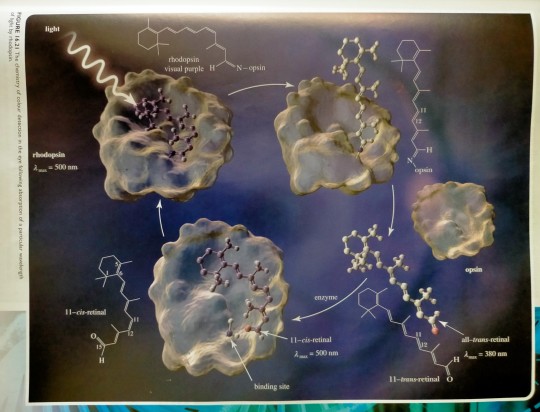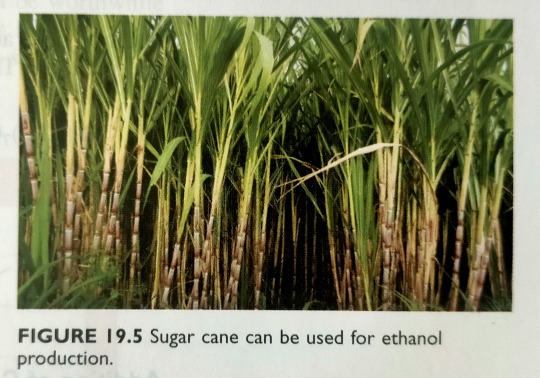#enzyme
Explore tagged Tumblr posts
Text
"A German bio-tech company has developed a naturally-occurring enzyme discovered in a cemetery into a near-market ready solution for recycling plastic without any loss of quality.
In 2022, GNN reported on a paper published by Leipzig-based scientists who first identified the enzyme. At the time, the enzyme was subject to a small side-by-side test, and caused the polyethylene terephthalate (PET) plastic to decompose by a whopping 90%.

Pictured: Before and After: A container of PET after 24 hours of contact with the enzyme leaves only dye
Fast forward to the spring of 2025 and those same scientists have perfected the capabilities of that enzyme, called PHL7, and have founded ESTER Biotech to bring those capabilities to market.
Their initial plan to be finished next year is a bathtub-sized pilot project reactor. If successful, their 2030 plan will be four 350 cubic-meter reactors capable of processing 45,000 metric tons of PET plastic every year.
PHL7 and ESTER Biotech boast several advantages over chemical and thermal recycling methods. For starters, once the polymers of PET are broken by the enzyme into monomers, or single component parts, they have suffered no degradation of their material characteristics unlike some recycled plastic which is weaker or less stable.
Additionally, PHL7 is exceptionally stable from 32 to 203 degrees Fahrenheit (0-95°C), and per kilogram of plastic, a dose of only 0.02% to 0.06% of the enzyme is required—substantially less than existing alternatives. Their new version of the enzyme also recycles the plastic several hours faster.
“Our technology makes it possible to bring material flows that are currently burned back to the beginning of the cycle at the molecular level,” says Christian Sonnendecker, lead author on the paper of the enzyme’s discovery, and co-founder of ESTER Biotech at the University of Leipzig. “And with high energy efficiency and scalability.”
“We are only at the beginning. But we are convinced that when science, entrepreneurial spirit and social responsibility come together, a cemetery enzyme can become a beacon of hope for a better future.”
RECYCLING BREAKTHROUGHS:
Scientists in Japan Develop Non-Toxic Plastic That Dissolves in Seawater Within Hours
Cornell Researchers Create First-of-its-Kind Durable and Recyclable Plastic
New Process ‘Vaporizes’ Plastic Bags and Bottles to Help Make Recycled Materials
Revolutionary New ‘Living Plastic’ That Could Slash Damage to the Environment Developed by California Researchers
ESTER Biotech’s enzyme is able to separate certain multilayer composites which are normally thought of as unrecyclable. In addition to the infrastructure of the pilot project, ESTER is currently working with two medium-sized partners to build a cost-efficient supply chain with an aim to reduce the enzyme price to between 100 and 200 euros per kilogram.
Though no currently-commercialized recycling method can compete with the cost of virgin plastic, a price between 100 and 200 euros will put it in line with existing competitors.
Fortunately for anyone in the space, the EU is not afraid to use heavy-handed regulation to guarantee plastic recycling rates. By 2040, under existing EU legislation, 65% of plastic production will be mandated to come from recycled sources. ESTER believes that with its potential to offer a higher quality “recyclate,” the incentive to pursue and expand enzymatic methods will increase."
-via Good News Network, June 13, 2025
#recycling#plastic#plastic pollution#environmental science#enzyme#waste#waste management#plastic recycling#germany#eu#europe#good news#hope
3K notes
·
View notes
Text
Absorption of light allows 11-cis-retinal to relax from a bent shape (arising from the cis double bond) to a lower energy, all-trans arrangement. The straighter all-trans-retinal can no longer fit in the receptor designed for 11-cis-retinal and is ejected. This change leads to differences in cell membrane potential and, as ions are pumped into the cell, this response turns into a nerve impulse that travels to the brain. That is not the end of the matter; the all-trans-retinal generated by this process is reconverted to 11-cis-retinal by specific enzymes, which can re-bind into the receptor, ready to interact with another photon of light.

FIGURE 16.21 The chemistry of colour detection in the eye following absorption of a particular wavelength of light by rhodopsin.
"Chemistry" 2e - Blackman, A., Bottle, S., Schmid, S., Mocerino, M., Wille, U.
#book quote#chemistry#nonfiction#textbook#light absorption#light#wavelength#rhodopsin#cis#trans#cell membrane#retinal#receptor#enzyme#opsin#photon#straight#oops all trans
38 notes
·
View notes
Text
Enzyme sona!!
What do we think about her?

5 notes
·
View notes
Text
youtube
Enzyme tape
34 notes
·
View notes
Text

#Kyoushoku Soukou Guyver#Guyver: The Bioboosted Armor#Guyver#Fukamachi Shou#Segawa Tetsurou#Makishima Genzo#Enzyme#Anime#gif
3 notes
·
View notes
Video
youtube
Enzyme - Golden Dystopian Age LP (Full Album)
31 notes
·
View notes
Text
This enzyme catalyses the oxidation of β-D-glucose to D-gluconic acid.

"Chemistry" 2e - Blackman, A., Bottle, S., Schmid, S., Mocerino, M., Wille, U.
#book quote#chemistry#nonfiction#textbook#enzyme#glucose oxidase#oxidation#chemical reactions#glucopyranose#glucose#gluconic acid
6 notes
·
View notes
Text
Big Flowers x Messiah Musik - Enzyme
1 note
·
View note
Text
There are two main sources of these sugars: sugar cane (figure 19.5) and grains.


"Chemistry" 2e - Blackman, A., Bottle, S., Schmid, S., Mocerino, M., Wille, U.
4 notes
·
View notes
Text
Even the Oldest Eukaryote Fossils Show Dazzling Diversity and Complexity - Technology Org
New Post has been published on https://thedigitalinsider.com/even-the-oldest-eukaryote-fossils-show-dazzling-diversity-and-complexity-technology-org/
Even the Oldest Eukaryote Fossils Show Dazzling Diversity and Complexity - Technology Org
The sun has just set on a quiet mudflat in Australia’s Northern Territory; it’ll set again in another 19 hours. A young moon looms large over the desolate landscape. No animals scurry in the waning light. No leaves rustle in the breeze. No lichens encrust the exposed rock. The only hint of life is some scum in a few puddles and ponds. And among it lives a diverse microbial community of our ancient ancestors.
A soft summer evening in the Paleoproterozoic, as envisioned by DALL-E. Image credit: DALL-E, prompt by Harrison Tasoff.
In a new account of exquisitely preserved microfossils, researchers at UC Santa Barbara and McGill University revealed that eukaryotic organisms had already evolved into a diverse array of forms even 1.64 billion years ago.
The paper, published in the journal Papers in Paleontology, recounts an assemblage of eukaryotic fossils from an era early in the group’s evolutionary history. The authors describe four new taxa, as well as evidence of several advanced characteristics already present in these early eukaryotes.
“These are among the oldest eukaryotes that have ever been discovered,” explained lead author Leigh Anne Riedman, an assistant researcher in UCSB’s Department of Earth Science. “Yet, even in these first records we’re seeing a lot of diversity.”
Eukarya forms one of the major domains of life, encompassing the plant, animal and fungi clades, as well as all other groups whose cells have a membrane-bound nucleus, like protists and seaweeds.
Many scientists had thought early eukaryotes were all fairly similar during the late Paleoproterozoic, and that diversification took place around 800 million years ago. But Riedman and her co-authors found fossils of a delightfully diverse, and complex, cast of characters in rock nearly twice as old.
Limbunyasphaera operculata is a new species that shows a small door opening into the cell. Photo Credit: Riedman et al.
Scientists knew from previous studies that eukaryotes had evolved by this time, but their diversity in this era was poorly understood. So Riedman headed to the Outback in late 2019. Within one week, she had collected about 430 samples from eight cores drilled by a prospecting company; they now reside in the library of the Northern Territory Geological Survey. The two cores used for this study spanned roughly 500 meters of stratigraphy, or 133 million years, with around 15 million years of significant deposition.
Riedman returned to the United States with shale and mudstone: remnants of an ancient coastal ecosystem that alternated between shallow, subtidal mudflats and coastal lagoons. A dip in hydrofluoric acid dissolved the matrix rock, concentrating the precious microfossils which she then analyzed under the microscope.
“We were hoping to find species with interesting and different characteristics to their cell walls,” Riedman said. She hoped that these features could shed light on what was happening within the cells during this time period. Reaching any conclusions about the cellular interior would require a great deal of sleuthing, though, since the fossils preserve only the exterior of the cells.
The researchers were surprised by the diversity and complexity preserved in these fossils. They recorded 26 taxa, including 10 previously undescribed species. The team found indirect evidence of cytoskeletons, as well as platy structures that suggest the presence of internal vesicles in which the plates were formed — perhaps ancestral to Golgi bodies, present in modern eukaryotic cells. Other microbes had cell walls made of bound fibers, similarly suggestive of the presence of a complex cytoskeleton.
The authors also found cells with a tiny trapdoor, evidence of a degree of sophistication. Some microbes can form a cyst to wait out unfavorable environmental conditions. In order to emerge, they need to be able to etch an opening in their protective shell.
Making this door is a specialized process. “If you’re going to produce an enzyme that dissolves your cell wall, you need to be really careful about how you use that enzyme,” Riedman said. “So in one of the earliest records of eukaryotes, we’re seeing some pretty impressive levels of complexity.”
Many people in the field had thought this ability emerged later, and the evidence for it in this assemblage further emphasizes how diverse and advanced eukaryotes were even at this early juncture.
“The assumption has always been that this is around the time that eukaryotes appeared. And now we think that people just haven’t explored older rocks,” said co-author Susannah Porter, an Earth science professor at UC Santa Barbara.
This paper is part of a larger project investigating early eukaryote evolution. Riedman and Porter want to know in what environments early eukaryotes were diversifying, why they were there, when they migrated to other places, and what adaptations they needed in order to fill those new niches.
A big part of this effort involves understanding when different characteristics of eukaryotes first arose. For instance, the authors are quite interested to learn whether these organisms were adapted to oxygenated or anoxic environments.
The former would suggest that they had an aerobic metabolism, and possibly mitochondria. Every modern eukaryote that’s been found descends from ancestors that possessed mitochondria. This suggests that eukaryotes acquired the organelle very early on, and that it provided a significant advantage.
Riedman and Porter are currently working on a fresh account of eukaryote diversity through time. They’ve also collected even older samples from Western Australia and Minnesota. Meanwhile, their geochemist collaborators at McGill are spearheading a study on oxygen levels and preferred eukaryote habitats, aspects that could shed light on their evolution.
“These results are a directive to go look for older material, older eukaryotes, because this is clearly not the beginning of eukaryotes on Earth,” Riedman said.
Source: UCSB
#Animals#Australia#billion#Biotechnology news#cell#Cells#Chemistry & materials science news#Community#complexity#dall-e#deal#diversity#domains#earth#Environmental#enzyme#eukaryotic cells#Evolution#Explained#Features#fibers#form#Forms#Fossils#fungi#Genetic engineering news#History#how#it#Landscape
2 notes
·
View notes
Text
youtube
Get with it shitheads
4 notes
·
View notes
Text

DNase test on unknown bacteria
#studyblr#microbio#microbiology#microbio lab#microbio laboratory#microbiology laboratory#laboratory#dnase#enzymes#bacteria#bacteriology#dnase test#dnase results#dnase enzyme#enzyme#enzyme test#enzyme tests#biology#bio#labs
6 notes
·
View notes
Text

In this Thorne Multi Enzyme review, we will delve into the effectiveness of this supplement, its target audience, its unique features, and if it merits the hype or is just another product on the shelf.
0 notes
Text
A Clear Definition of Enzyme Kinetics: Key Concepts and Importance
Enzymes are special proteins that help speed up important chemical reactions in our bodies. Without enzymes, many processes like digestion or energy production would happen too slowly for us to survive. To learn how enzymes work and how fast they make these reactions happen, scientists study something called enzyme kinetics. This field explains how enzymes and the substances they work on, called…
#enzyme#Enzyme activity and reaction rate#Enzyme Kinetics#Enzyme kinetics definition#Michaelis-Menten equation explained
0 notes
Link
#Enzyme#Gesundheitstips#Hitzeanpassung#Hitzestress#ImmunsystemStärken#Klimawandel#Kreislaufprobleme#Naturheilkunde#Sommergesundheit#Stadtökologie
0 notes
Text
youtube
0 notes